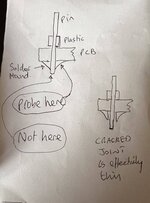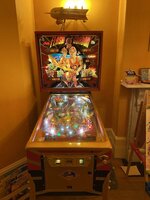We are troubleshooting lighting issues on our Flash Gordon - we have replaced all the bulbs with Comet LEDs, and the vast majority work but we have a small number of lights which are either out or on all the time (I have removed the bulbs from these to avoid damaging anything else if there is a short). I am struggling to work out whether the problem is with the light fittings, the connections, or a blown thyristor on the lighting board.
In particular, I am not succeeding in getting useful information with a multimeter. I am getting 470 ohms across the good LEDs in situ, but I don't seem to be able to get anything except an open circuit with the new fittings I was planning to install - neither the resistance mode nor the diode mode is doing anything if I put a LED in the socket and connect the multimeter across it. Also, does anyone know what voltages I should expect on the individual LED wires when the lamp test is running? I know the common return wire is high (about +7V relative to the cabinet ground) all the time and the signal wires go low to turn on.
We got the new fittings and light board from @AlanJ And I owe him the old light board once we're done
And I owe him the old light board once we're done 
In particular, I am not succeeding in getting useful information with a multimeter. I am getting 470 ohms across the good LEDs in situ, but I don't seem to be able to get anything except an open circuit with the new fittings I was planning to install - neither the resistance mode nor the diode mode is doing anything if I put a LED in the socket and connect the multimeter across it. Also, does anyone know what voltages I should expect on the individual LED wires when the lamp test is running? I know the common return wire is high (about +7V relative to the cabinet ground) all the time and the signal wires go low to turn on.
We got the new fittings and light board from @AlanJ


